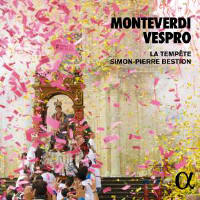Texte paru dans: / Appeared in:
Alpha |
|
|
Reviewer: J.
F. Weber
We have not had a recording of
this Vespers that runs two hours and 20 minutes, so some expansion must have
been done. It is an arrangement of the work by Simon-Pierre Bestion, his
fourth recording for this label but the first to be reviewed here. In the
work itself, the orchestration is revised, the continuo is expanded using
every suitable instrument, and a long instrumental introduction is added to
Laetatus sum. He tampers with the doxology of the canticle (“not just one
echo of the angel’s voice, as in Monteverdi, but three distant echoes,” he
says in the notes), but strips the hymn of Monteverdi’s polyphony, leaving
just the original chant melody. The opening versicle, the five psalms, and
the canticle are duplicated, first sung in fauxbourdon and then repeated in
Monteverdi’s setting. Fauxbourdon, a familiar practice that originated with
Guillaume Du Fay but was known even in the 20th century, is a simple form of
parallel harmony in which psalms are sung using the psalm tone assigned in
the liturgy with harmonizing voices a sixth and a fourth below (a fourth
part is often added). He brings to the fauxbourdon what he calls in the
notes “a rough-hewn kind of polyphony, sung by natural voices that can sound
quite raucous.” Indeed he does, and raucous is not pleasant. The idea of
singing the Vespers twice, both in fauxbourdon and in Monteverdi’s Baroque
version, is bizarre. Six Gregorian antiphons are supposedly added before the fauxbourdon settings (they are not repeated after), but the source is cited as the Graduale Triplex, the book of Mass Propers. None of these chants belongs in a Vespers of any kind. He chooses the introit Gaudeamus omnes, the alleluia verse Diffusa est gratia, the alleluia verse Tota pulchra es, the offertory Recordare virgo, the alleluia verse Felix es sacra Virgo, and an Assumpta est Maria chant that is not found in the Graduale Triplex at all. All are sung by a soloist who interprets the melodies in her own way, varied in the way melodic restorations might be sung, but all five (as well as the final, unidentified chant) are totally inappropriate choices, not antiphons, not even Office chants. The sonata is also sung by a soloist. One more addition is the Frescobaldi Ricercar on Sancta Maria that Hermann Max and Bruno Boterf (42:4) have also inserted into their recordings, after the fourth psalm here. They did so because they were performing the reduced celebration, using the Magnificat à 6 without concertato instruments.
This
overblown version of Monteverdi’s masterpiece is of no interest. Sad to say,
for in the notes Bestion describes his childhood experience of spending
family vacations near a monastery where they experienced the daily
liturgical observances, “caught up in that atmosphere,” he says. At the age
of 20 he came to love the Monteverdi Vespro. How this experience resulted in
the performance we have here is beyond understanding. It’s a shame because
much of the singing is very fine. I believe he is sincere in his
appreciation of the music, but it is not the Vespers we deserve to have on
records. It is an unfortunate aberration. If you want your money’s worth in
playing time, the complete 1610 publication from Masaaki Suzuki (25:2) or
Robert King (29:6) will give that. For the usual Vespers with one canticle,
Rinaldo Alessandrini (28:2) is superb in a minimalist way. Jörg Breiding
(35:6) is a fine version with the simple addition of chant antiphons. | |
|
|
|
|
|
|
|
Cliquez l'un ou l'autre
bouton pour découvrir bien d'autres critiques de CD |
|




